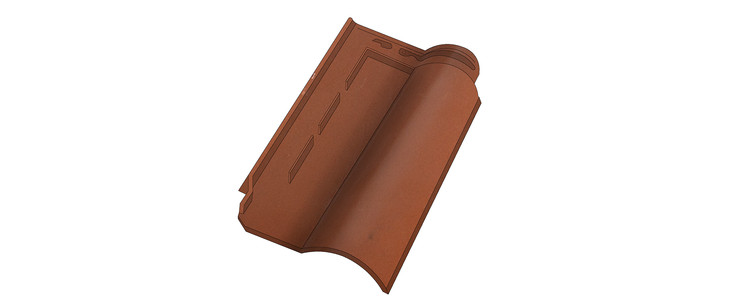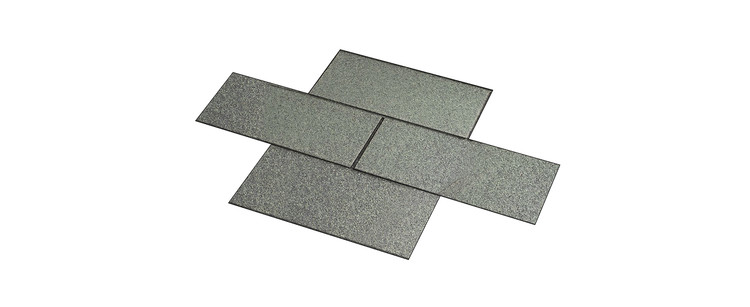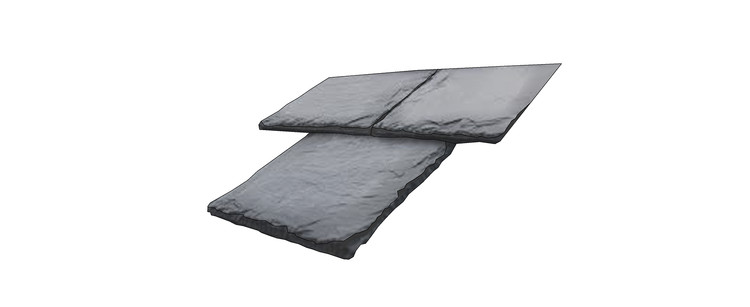
From ceramic tiles and metal sheets for roofs to wooden decks and floating cement tiles for roofing, roofing materials not only contribute to the drainage and protect the lower layers from solar radiation and wear, but also have an important aesthetic function.
Currently, when choosing the roof covering, you can find a wide variety of materials and dimensions, each with specific characteristics, determined by the type of roofing, the location of the project, and its future maintenance.
Review a catalog of options to incorporate creatively into your designs, below.
Tiles
Available for different types of sloping roofs, they usually provide good drainage and rain resistance. Usually, they consist of a superposition of upper pieces, which collect and lead rainwater, and lower pieces, which cover the joints between the channels. Their production costs are relatively low and they are manufactured in different materials, which is why they are found regularly in most low-density residential housing.
- Ceramic Roof Tile: Curves, flat or mixed, each with different joints, the tiles are made through the drying and cooking of a clay mixture. They are fire resistant, durable and require little maintenance, although they do not have a high impact resistance.

- Enameled Roof Tile: The enamel in the ceramic tiles allows different colors and finishes to be used, enabling the reflection and absorption of solar radiation by color. For this reason can be more expensive, although they are more resistant to water and wear.

- Concrete Roof Tile: They have better mechanical resistance, a greater weight and less water absorption than a ceramic tile. Advisable for colder climates, since they resist frost and winds better.

- Glass Roof Tile: Recyclable and durable, they are usually placed on a black base nylon, which absorbs heat and transmits it to the air circulating under the tiles, thereby reducing heating costs.

- PVC Roof Tile: They are light and resistant to chemical agents and corrosion. They have a good seal and do not absorb water, so they can be cleaned. They are found with different designs and dimensions, although their size is greater than that of conventional tiles, which allows a faster installation.

- PET Roof Tile: Manufactured with recycled PET bottles, they are very light, economical and resistant to biodegradation. They come in different dimensions and designs.

- Metallic Roof Tile: Light and easy to install. Generally, they do not offer a good thermal insulation, causing an increase in the interior temperature. It's necessary to consider oxidation and corrosion depending on the type of metal and its covering.

- Asphalt Roof Tile: Generally composed of asphalt laminate and reinforcement material, such as ceramic grains. They are found in different designs and thicknesses. They are economical, although they have a shorter life compared to other materials.

- Photovoltaic Roof Tile: They allow the production of electric energy, although installation and production costs are high. The effectiveness of the system depends on orientation towards the sun.

- Wood Roof Tile: Properly installed, the wooden pieces can provide lasting protection and rustic aesthetics, although they are more prone to attack by biological agents and wear due to weather conditions.

- Slate Roof Tile: They are flat pieces of rock with different shapes and sizes. They should be anchored well because they are located on very steep roofs to favor drainage.

Sheets and Panels
Although they usually require the incorporation of adequate thermal insulation, they have great benefits when it comes to resisting the weather. They usually have a high durability, and due to their size and weight, they can be handled and placed quickly and easily. They can be found with various forms of section that increase the inertia of the sheet, so that you can even find self-supporting sheets.
- Zinc Galvanized Steel Sheet: Due to its coating, they are protected against corrosion and oxidation of steel. They require little maintenance and have great durability. Like other sheets, they have poor acoustic and thermal quality. They generate an excess of noise due to the impact of the rain. Despite this, they are an excellent option because of their light weight and low price.

- Stainless Steel Sheet: Although they are not economical, they require little maintenance and a long duration, therefore they have a good cost / benefit ratio. They are resistant to corrosion, impact, and extreme climates. Like other sheets, their surface can be scratched or dented, and they are difficult to repair.

- Copper Foil: They can be adapted to different forms but they are not economical, both in terms of the material and the cost of their installation. They stand out for their resistance to temperature changes, their durability, and their final decorative aesthetic.

- Thermoacoustic Metallic Sheet: Although they have a higher cost than other metal sheets, because they are covered with thermal and acoustic insulation, they offer great advantages in relation to the control of temperature and noise. They are durable and do not require major maintenance.

- Polycarbonate Sheet: Best features are its resistance, lightness and easy installation. Its transparency allows for the entry of sunlight and the sheet can be found in different thicknesses. Depending on the climate, when using this type of roof it may be necessary to consider thermal insulation.

- Fiber Cement Sheet: They are durable, do not require complicated maintenance, and can withstand low temperatures. They come with different profiles, textures and colors, and have an intermediate cost in relation to other options. Because of their weight, they are usually more difficult to install.

- Fiberglass Sheet: They offer good thermal insulation and can withstand high temperatures. The characteristics of the material allow it to be moldable to support with minimal resources. They are also fairly inexpensive.

Wood Slats and Vegetable Fibers
As a widely available natural resource, plant fibers are economical and have a good resistance to rain, although they can be easily attacked by biological agents or by strong winds. Similar to wood, they require periodic maintenance because they degrade rapidly and present a fire hazard.
- Straw: They are economical although a large percentage of the cost falls on the labor of installation. They present an excellent thermal and acoustic insulation but may be difficult to use in places where it may be a fire hazard or be destroyed by animals.

- Bamboo: The bamboo canes are cut to the middle or in quarters, according to the necessary length, giving a kind of superposition of 'gutters.' They can be fixed with ropes or nails.

- Wooden Deck: Used in flat roofs, the decks provide a good option for exterior decoration. This option requires periodic maintenance and it's necessary to have a bottom surface for drainage and ventilation.

Ceramics and Gravel
This category presents finishing materials for flat roofs, among which are pieces that rise on supports or pieces placed on a mortar bed. This type of roof, depending on its use, can also be protected with other surface elements, such as gravel, soil and vegetation, in order to provide adequate drainage and waterproofing.
- Technical Floors: They are placed on adjustable or fixed supports, which allow easy maintenance of the lower layers and replacement in case of breakage. They offer a ventilated cover and can be used to hide pipes or installations.

- Ceramic Tile: Can be applied on a mortar bed, with flexible joints that can absorb the tensions of the tiles produced by the dilatations. They must be waterproof to resist rainwater and can be found in different dimensions and thicknesses.

- Gravel: They are fragmented rocks in small dimensions that prevent the erosion produced by the wind, while protecting the lower layers of the sun's rays. They are heavier than other materials, so they may require structural reinforcement.

Membranes
They stand out for their easy application and for presenting a good quality / price ratio. They are light and their maintenance and repairs depend on the use of the roof. Although they are usually used in most contemporary covers, they do not usually present a decorative enhancement.
- Waterproof Elastic Membrane: They can be easily applied as paint, have a high level of coating, and when dried they make up an elastic membrane with waterproof properties. The temperature conditions of the area and the accessibility of the roof must be taken into account when applying them.

- Asphalt Membrane: They require a correct placement since they must be joined in situ in order to obtain an adequate continuity of the membrane. Generally they come in widths of 1 meter. They can be found with different finishes (geotextile or aluminum coating) that will give better mechanical strength or better protection against sunlight.

This article presents the necessary information to start a roof project. The construction should only proceed after evaluating local technical norms and taking into account the precedent decisions by architects and/or professionals in the area.


